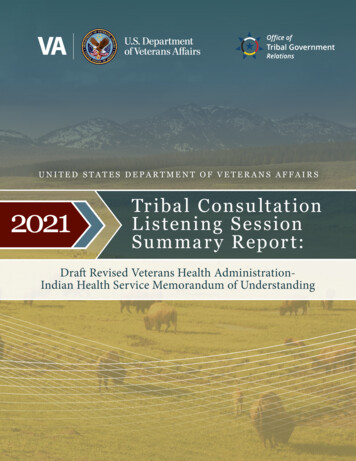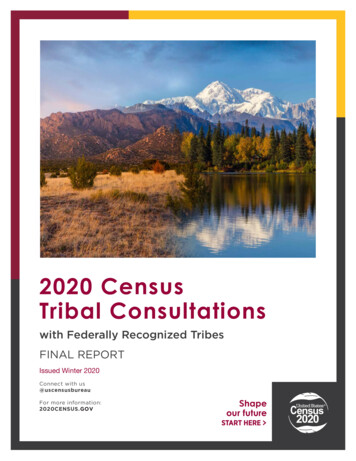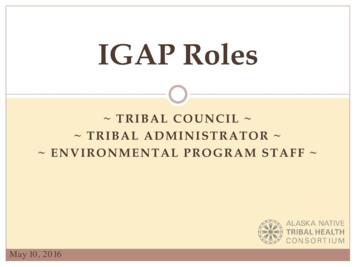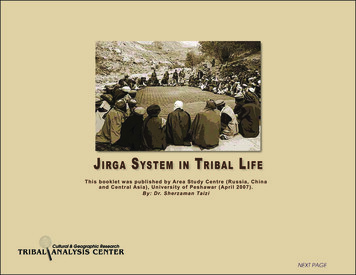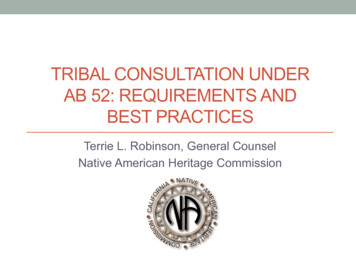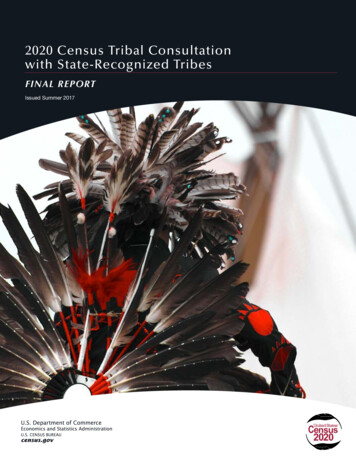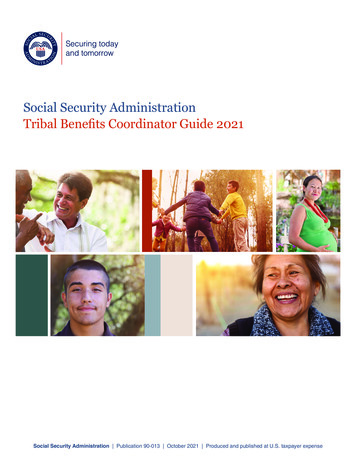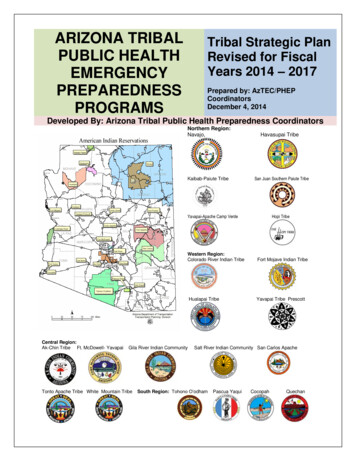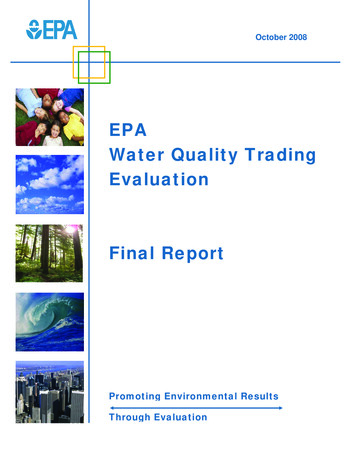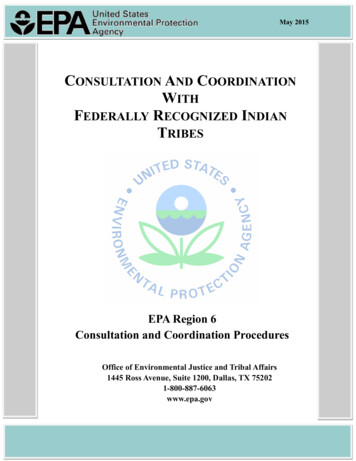
Transcription
May 2015CONSULTATION AND COORDINATIONWITHFEDERALLY RECOGNIZED INDIANTRIBESEPA Region 6Consultation and Coordination ProceduresOffice of Environmental Justice and Tribal Affairs1445 Ross Avenue, Suite 1200, Dallas, TX 752021-800-887-6063www.epa.gov
Table of ContentsIntroduction. 31. The Consultation Process . 41.1 Identification Phase .41.1.2 Activities Not Subject to Consultation . 41.2 Notification Phase .51.2.1 EPA Consultation Outreach .51.2.2 Consultation with Small Number of Tribes. 61.2.3 Consultation with All or Large Number of Tribes .61.2.4 If a Tribe(s) Chooses to Consult .61.2.5 If a Tribe(s) Declines to Consult .71.3 Input Phase . 71.3.1 Coordination .71.3.2 Consultation .71.4 Follow-up Phase .81.4.1 Considering Tribal Input . 81.4.2 Responding to Tribal Concerns and Closing Out the Consultation Process .82. Documenting and Reporting . 82.1 Division . 82.2 Required Reporting .93. Historical and Archaeological Resources . 9Tribal Consultation Flow Chart .10Federally Recognized Indian Tribes of EPA Region 6 .11May 20152
IntroductionPurpose and ScopeEPA’s National Tribal Consultation Policy is to consult on a government-to-governmentbasis with federally recognized Tribal governments when EPA actions and decisions may affect aTribe. The EPA Policy on Consultation and Coordination with Indian Tribes (May 4, 2011) (“EPATribal Consultation Policy”) establishes national guidelines and institutional controls forconsultation across EPA. The Region 6 Tribal Consultation and Coordination Procedures(“Procedures”) are consistent with the agency-wide consultation policy, but include more specificguidelines for the consultation process to increase the effectiveness of working with Tribes inRegion 6.These Procedures do not supersede any EPA agency-wide consultation policies orprocedures, or those developed by individual Tribes. These Procedures do not replace individualEPA-Tribal memoranda of agreement, consultation plans, Tribal Environmental Agreements(TEAs), or other specific agreements between Region 6 and a Tribe or Tribes. These Proceduresdo not apply to the Region 6 formal civil enforcement process or consultations initiated by EPAHeadquarters. Primary guidance on consultation on civil compliance monitoring andenforcement actions is found in the Guidance on the Enforcement Priorities Outlined in the 1984Indian Policy, Questions and Answers on the Tribal Enforcement Process and the Region 6Guidance on Compliance Monitoring, and Compliance Assistance, and Civil Enforcement at TribalFacilities.For Tribal consultation regarding Superfund activities, discuss with the Region 6 TribalConsultation Advisor as early as possible. Additional information is available in Consulting withIndian Tribal Governments at Superfund Sites: A Beginner's Booklet at t text.htm. This supplemental information does not supersedethe EPA Tribal Consultation Policy or these Procedures.DefinitionsEPA’s National Tribal Consultation Policy provides the following definitions:Consultation is a process of meaningful communication and coordinationbetween EPA and Tribal officials that begins prior to EPA taking actions or implementingdecisions that may affect Tribes. As a process, consultation includes several methods ofinteraction that may occur at different levels.Tribal Consultation Advisors (TCAs) are the in-office subject matter experts thatassist staff and management in the implementation of the EPA Tribal Consultation Policy.TCAs assist in identifying matters appropriate for consultation and prepare summaryinformation on consultation activities and provide it to AIEO. TCAs receive and provideadvice within their respective program offices and regions on what actions may beappropriate for consultation. TCAs also serve as a point-of-contact for EPA staff, Tribalgovernments, and other parties interested in the consultation process. For Region 6, theTCA is the Office of Environmental Justice and Tribal Affairs Director or Designee.May 20153
1. The Consultation ProcessTribal Consultation may commence when Tribal officials request consultation as well aswhen EPA identifies matters appropriate for consultation. EPA honors the Tribal government’srequest with consideration of the nature of the activity, past consultation efforts, availableresources, timing considerations, and all other relevant factors. The appropriate level ofinteraction initiated by Region 6 is determined by past and current practices, with adjustmentsmade as needed consistent with the EPA Tribal ConsultationPolicy.Tribal Consultation at EPAconsists of four phases: Identification1.1 Identification Phase Notification InputDuring the identification phase, EPA identifies activities Follow-upthat may be appropriate for consultation. The identificationphase should include a determination of the complexity of theactivity, its potential implications for Tribes, and any time and/or resource constraints relevantto the consultation process. This phase should also include an initial identification of thepotentially affected Tribe(s).A wide range of EPA Region 6 activities are appropriate for consultation under the EPATribal Consultation Policy. Regional activities may include the development of regulations,rules, permits, guidance documents, policies, directives, budget and priority planningdevelopment, legislative comments, civil enforcement and compliance monitoring actions,response actions and emergency preparedness, state or Tribal authorizations or delegations,and EPA activities in implementation of United States’ obligations under an international treatyor agreement. The EPA Tribal Consultation Policy makes clear that certain actions, such aslegislative comments and EPA’s enforcement authorities, may be subject to policy and timeconstraints. EPA Region 6 defines “actions” as regulatory or policy decisions, but notnecessarily every step taken within a decision-making process.1.1.2 Activities Not Subject to ConsultationRoutine administrative and staff-to-staff level interactions occur between EPA Region 6and Tribal government employees on a regular basis. The EPA Tribal Consultation Policy is notintended to apply to these regular, ongoing interactions. These include grantee-project officerdiscussions, requests for publically available information, grant funding decisions, review ofprogress reports, programmatic evaluations with the Tribe and other routine communications.In addition, there are some areas of EPA Region 6’s operations that are not appropriate forconsultations. These include strictly internal Agency operations (activities and decisionsrelated to staffing, personnel, and human capital management; oversight of contractorperformance under Agency-issued contracts; administration of the Agency’s working capitalfunds, etc.). This also includes areas where the Agency lacks discretion (e.g., congressionallymandated time lines, actions, or other requirements; Agency response to court orders; andprivileged or confidential Agency activities).May 20154
1.2 Notification PhaseOnce the appropriate EPA Region 6 Division and TCA determine that consultation iswarranted, EPA Region 6 shall send a letter to the appropriate Tribal government(s) either offeringto consult or initiating consultation. The notification phase should precede any public commentperiod associated with the proposed action by at least 30 days. EPA Region 6 strives to notify a Tribeor Tribes of the opportunity to consult as early as possible to enhance meaningful discussion.1.2.1 EPA Consultation OutreachOnce the appropriate EPA Region 6 Division and TCA determine that an action may affect aTribe(s), EPA Region 6 shall send a letter notifying Tribal government(s) of the opportunity toconsult with EPA.Invitations To Consult (Notification): Working with the TCA, the appropriate Division/program staff will draft an invitation letter to the Tribal leader(s) for the Division Director’ssignature, with the TCA’s concurrence.The letter should: Be addressed to the Tribal Leader, with a copy to the Tribe’s program staff, and bcc tothe appropriate Division and the TCA;Be signed by the appropriate Division Director or the Regional Administrator;Describe the issue at hand clearly, avoiding or clearly defining legal and technical termsand acronyms;Provide maps, technical data, and other explanatory or supporting information asappropriate and available;Relay process timelines and schedule considerations;Identify the EPA Region 6 point of contact whom the Tribe may contact to seekadditional information;Request that the Tribe(s) respond in writing to the Division or TCA, within a specifiedtimeframe indicating whether or not the Tribe(s) wants to pursue consultation andindicate that if no response is received, EPA will assume the Tribe has declinedconsultation;If appropriate, request the Tribe(s) identify an official representative who will serve asthe Tribal point of contact for planning the consultation and/or coordination activitiesand authority to speak on behalf of the Tribe during the consultation, if not Triballeadership;Include summary factsheet with brief statement of action to enable Tribalenvironmental staff to brief Tribal leadership as appropriate.Response To Request For Consultation: In cases where a Tribe has addressed a letter to theRegional Administrator requesting consultation, the appropriate Division/program staff, incoordination with the TCA, will draft a response letter for the Regional Administrator’s signature.The Division should circulate that letter for review, comment and concurrence by the TCA, ExternalAffairs and the appropriate Division Director, and Office of Regional Counsel.May 20155
The letter should: Be addressed to the Tribal Leader with a copy to the Tribe’s program staff (e.g.Environmental Director);Have the concurrences of the TCA, OEJTA Director, Division Director, External Affairsand the Regional Counsel;Be signed by the Regional Administrator;If requested, provide maps, technical data, and other explanatory or supportinginformation as appropriate and available;Relay process timelines and schedule considerations;Identify the EPA Region 6 point of contact whom the Tribe may contact to seekadditional information;If appropriate, request that the Tribe (s) identify an official representative who willserve as the Tribal point of contact for planning the consultation and/or coordinationactivities and may also be able to speak on behalf of the Tribe during the consultation,if not Tribal leadership1.2.2 Consultation with Small Number of TribesWhen EPA Region 6 has determined that consultation is appropriate and that morethan one Tribe may be affected, the appropriate Division and TCA shall work together todevelop an approach to consultation. The same protocol above will be applicable inaddition to terms to be negotiated, depending on available resources, which may include: Whether the consultation will be conducted in a meeting, conference calls, or otherappropriate interactions depending upon specific circumstances involved;The timing and location (s) of the interactions;The overall goal or desired outcome of the consultation for each party;What issues related to the proposed action will be the focus of the consultation;Representatives that will participate on behalf of EPA Region 6 and the Tribe; andTimetable for the consultation (e.g., start and end dates of the consultation period,anticipated meeting dates, and other dates relevant to the EPA action such as publiccomment periods).1.2.3 Consultation with All or Large Number of TribesWhen a larger group of Tribes or all Tribes in EPA Region 6 could potentially beaffected by an action, a notification letter engaging those Tribes in consultation is extendedto the large group of Tribes or all Tribes in EPA Region 6 in accordance with section 1.2.1above. EPA Region 6 will work to ensure consultations carried out with all or a largenumber of Tribes are done in a mutually agreeable and meaningful method, including butnot limited to centralized locations in areas close to many of the Tribes.May 20156
1.2.5 If a Tribe(s) Declines to ConsultIf a Tribe(s) indicates it does not wish to consult on a particular matter, EPA consultationefforts are normally concluded. This does not relieve EPA Region 6 of any trust responsibility itmay have or the obligation to reinitiate consultation efforts in the future if changes warrantsuch action.The TCA will enter the relevant data into the Tribal Consultation Opportunities TrackingSystem (TCOTS) for tracking purposes. Enforcement and compliance issues where a Tribe is arespondent will not be entered in TCOTS .1.3 Input PhaseDuring the Input Phase, tribes provide input to EPA Region 6 on the consultation matter.This phase may include a range of interactions including written and oral communicationsincluding exchanges of information, phone calls, meetings, and other appropriate interactionsdepending upon the specific circumstances involved.1.3.1 CoordinationWorking in coordination with the TCA, regional and Tribal staff discuss consultationmeeting logistics such as location, date, time, agenda items and expected attendees from EPAand the Tribe. Additionally, information needs related to the issue being consulted on should beidentified, such as the dissemination of technical documents such as maps or monitoring data,legislative notices, judicial decisions or orders, and other relevant information. Informaloutreach like websites, webinars, Tribal organizational meetings and Tribal conferences may beused to further discussions of issues as part of the consultation process to ensure Tribes haveadequate information to formulate a position; however, such informal communications do notconstitute or substitute for consultation with Tribal governments. There may also be occasionswhere EPA Region 6 coordinates with other EPAregions on consultations with Tribes that may haveDuring ConsultationEPA Region 6 and the Tribe:concerns across more than one region.1.3.2 ConsultationOpen dialogue between the Region and theTribe(s) is expected during the input phase.Technical staff from the Region may also beavailable to answer questions directly from Triballeadership during the consultation. Discuss how the action originated; Discuss how the Tribe may be impacted; Identify any technical and/or funding assistancethat the Region may be able to provide, if relevant; EPA listens to the input from the Tribe and considers effects of the proposed action through ameaningful dialogue with Tribal leadership andFollowing the initial consultation meetingand to the extent allowed by law, EPA Region 6 will take Tribal comments and concerns underconsideration and work to address these issues. This may include the need to undertakesubsequent rounds of consultation to address unresolved questions, provide additionaltechnical information, update the Tribe on significant changes in the originally proposed activity,or to address new issues that may arise.May 20157
1.4 Follow-Up PhaseDuring the follow-up phase, EPA Region 6 provides feedback to the Tribe(s) involved in theconsultation to explain how their input was considered in the final action.1.4.1 Considering Tribal InputThe Division Director and staff, in collaboration with the TCA and Office of RegionalCounsel, will consider the Tribal input, weighing how program decisions can or should address theconcerns raised by a Tribe or Tribes. To the fullest extent allowed by law and policy, EPA Region 6will incorporate the input of the Tribe(s).1.4.2 Responding to Tribal Concerns and Closing out the ConsultationProcessA written response to the concerns raised by the Tribe(s) during consultation should bedrafted by the Division, with concurrence by the TCA and the Office of Regional Counsel (ifnecessary), and signed by the appropriate Division Director, or the Regional Administrator whenappropriate. For consultations requiring subsequent meetings, the written response will identifyany follow up action items resulting from the meeting. The response letter will explain how EPARegion 6 considered the input from the Tribe(s) in its final decision.For issues or concerns that are beyond the scope or subject matter of the consultation, aresponse acknowledging the issues or concerns should be included. This response letter will be sentto the Tribal leader or the Tribe’s designated representative for the consultation, with a copy to theTCA.2. Documentation and Reporting2.1 DivisionThe Division Lead maintains digital and paper project or site files for each consultation, whichmay include: Letters or emails inviting Tribe(s) to consult and responses from Tribe(s) or follow-up actions byEPA Region 6;Consultation schedule, fact sheets, issues list, agenda for consultation meeting(s);Notes from any meetings, conference calls, webinars, or video conferences, including names ofall participants for the Tribe(s) and EPA Region 6;EPA Region 6’s written responses to concerns raised by the Tribe(s) throughout theconsultation process; andClose out letter(s) explaining EPA Region 6’s final decision on consultation.Digital copies of all consultation correspondence shall also be stored in the EPA Region 6 TribalConsultation folder located on the regional share drive.May 20158
2.2 Required ReportingAs outlined in the EPA Tribal Consultation Policy, EPA American IndianEnvironmental Office (AIEO) submits annual progress reports to the Office of Managementand Budget in June of each year on the status of the consultation process and actions onwhich consultation occurred, as well as plans for consultation on Agency actions in thecoming year.To facilitate submission of the annual progress reports, EPA Region 6 is required toprovide a report of anticipated consultations by October 1 and April 1 of each year using theTribal Consultation Opportunities Tracking System. This requirement is pursuant to theNovember 5, 2009 Presidential Memorandum directing all executive departments andagencies to develop a detailed plan of action to implement Executive Order 13175,Consultation and Coordination with Indian Tribes. Tribal consultations will be entered in theTribal Consultation Opportunities Tracking System (TCOTS) by the TCA and trackedaccordingly until conclusion of the consultation1. The TCA will also maintain internalrecords for consultation invitations not accepted by the Tribe(s) but that were offered. EachEPA Region 6 Division that participates in consultation activities must provide (in a form tobe agreed upon by the Division Director and TCA) a list of potential or projectedconsultations to the TCA by September 1 and March 1 of each year. After managementreview and approval, the TCA submits the semi-annual consultation plans to AIEO.3. Historical or Archaeological ResourcesThese procedures do not govern or necessarily relate to consultations that mayoccur with a Tribe pursuant to other statutes regarding historical or archaeologicalresources. For example, consultations pursuant to Section 106 of the National HistoricPreservation Act of 1966 (NHPA) will be conducted in accordance with the requirements ofthat statute and implementing regulations. EPA understands that consultations underNHPA or other laws such as the Native American Graves Protection and Repatriation Act of1990 or the National Environmental Policy Act (NEPA) may have requirements that overlapwith a consultation under the EPA Tribal Consultation Policy. In these instances, EPAprogram staff should also work with the Region 6 Tribal law advisor/cross-cutting lawattorney to ensure that Tribal consultations are conducted in a way that ensures compliancewith any additional federal statutory requirements for protected resources.1May 2015Certain compliance monitoring and enforcement activities are not included in TCOTs.9
Region 6 Consultation and Coordination ProcessIDENTIFICATIONPHASERegion 6 or Tribe(s)IdentifyActions Which MayAffect a Tribe or TribesDivision/Program and TCA Identify ActionsTribe Identifies Action or Issuesand Requests ConsultationCoordination with Tribes, Partnerships & Workgroups (e.g. RTOC)NOTIFICATION PHASERegion 6 notifies Tribesof proposed EPA actionand opportunity toconsult on the actionOR responds to Tribe’srequest for consultation.Division and TCADevelop ConsultationNotification, Plan andTimeline Coordination and in-INPUT PHASEEPA Engages WithInterested TribesthroughConsultationNotification Includes Point of Contact Factsheet and background info on Agencyactivity/action Anticipated TimeFrame for Process Maps, technical information or other appropriate supporting information Conference Calls In-Person Meeting Other preferredmethodformation among EPAand Tribal staffthroughout process May include morethan one meetingFOLLOW UP PHASEEPA Follows Up WithLetter to ConsultingTribes on Final AgencyDecision and HowTribes’ Input ConsideredMay 201510
Federally Recognized Indian Tribes of EPA Region 6LouisianaChitimacha Tribe of LouisianaCoushatta Tribe of LouisianaJena Band of Choctaw IndiansTunica-Biloxi Indians of LouisianaTexasAlabama-Coushatta Tribe of TexasYsleta del Sur Pueblo of TexasKickapoo Traditional Tribe of TexasNew MexicoPueblo of AcomaPueblo of IsletaJicarilla Apache NationPueblo of LagunaPueblo of NambePueblo of PojoaquePueblo of Santa AnaPueblo of San IldefonsoPueblo of Santa ClaraPueblo of TesuqueZuni TribePueblo of CochitiPueblo of JemezPueblo of Santo DomingoMescalero Apache TribePueblo of PicurisPueblo of SandiaPueblo of San FelipeOhkay OwingehPueblo of TaosPueblo of ZiaOklahomaAbsentee-Shawnee TribeApache TribeCherokee NationChickasaw NationCitizen Potawatomi NationDelaware NationEastern Shawnee TribeIowa TribeKialegee Tribal TownKiowa Indian TribeModoc TribeOsage NationOttawa TribePeoria Tribe of IndiansQuapaw TribeSeminole NationShawnee TribeTonkawa Tribe of IndiansWichita and Affiliated TribesMay 2015Alabama-Quassarte Tribal TownCaddo NationCheyenne and Arapaho TribesChoctaw NationComanche NationDelaware Tribe of IndiansFort Sill Apache TribeKaw NationKickapoo TribeMiami TribeMuscogee (Creek) NationOtoe-Missouria NationPawnee NationPonca Tribe of IndiansSac & Fox NationSeneca-Cayuga TribeThlopthlocco Tribal TownUnited Keetoowah Band of CherokeeWyandotte Nation11
Office of Environmental Justice and Tribal Affairs 1445 Ross Avenue, Suite 1200, Dallas, TX 75202 1-800-887-6063 www.epa.gov May 2015. May 2015 2 Table of ontents . environmental staff to brief Tribal leadership as appropriate. Response To Request For Consultation: In cases where a Tribe has addressed a letter to the .

